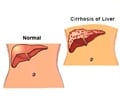Two new studies have tested non-invasive alternatives to liver biopsy, in order to examine live diseases like liver fibrosis or cirrhosis.
Two new studies have tested non-invasive alternatives to liver biopsy, in order to examine live diseases like liver fibrosis or cirrhosis.
The results reveal that an enhanced version of the Original European Liver Fibrosis panel showed promise to have good diagnosis of fibrosis in patients with non-alcoholic fatty liver disease.However, the second alternative — transient elastography — was found to be unreliable for detecting cirrhosis in patients with acute liver damage.
Liver biopsy is considered to be the best way to examine liver fibrosis or cirrhosis. However, it is invasive in nature, and may lead to potentially severe complications.
For long, scientists have been looking for less invasive techniques to diagnose liver disease, thereby developing and testing clinical tools, like the Original European Liver Fibrosis Panel and transient elastography.
The first study was led by William Rosenberg in the United Kingdom to confirm the efficacy of the Original European Liver Fibrosis panel, and consider a simplification that could remove age as a factor yielding the Enhanced Liver Panel.
The researchers went on to test the diagnostic performance of the ELF panel with the addition of the following simple markers: age, BMI, presence of diabetes/impaired fasting glucose, AST/ALT ratio, platelets, and albumin.
Advertisement
The researchers discovered that the Enhanced Liver Fibrosis panel detected severe fibrosis, moderate fibrosis and no fibrosis at AUCs of .90, .82, and .76 respectively. The diagnostic accuracy of the ELF panel plus simple markers was .98, .93 and .84 respectively.
Advertisement
“The ELF panel has good diagnostic accuracy in an independent validation cohort of patients with NAFLD. The addition of established simple markers augments the diagnostic performance across different stages of fibrosis, which will potentially allow superior stratification of patients with NAFLD for emerging therapeutic strategies,” concluded the authors.
At the same time, German researchers led by Abdurrahman Sagir made use of transient elastography — Fibroscan (FS), in order to assess liver stiffness in 20 patients with acute hepatitis.
The test came out with liver stiffness values, indicating cirrhosis in 15 (75 percent) patients. Still, no patient displayed any signs of cirrhosis in a physical exam, on ultrasound, or in liver histology.
“Liver stiffness measurement by FS in patients with acute liver damage overestimate the real stage of fibrosis and may erroneously suggest the presence of liver cirrhosis,” reported the authors.
The researchers suggested that this stiffness might be linked to hepatocyte swelling, cholestasis, or infiltrates of inflammatory cells in the inflamed liver.
“FS results need to be interpreted with caution in patients with acute liver damage and high values of liver stiffness do not predict the simultaneous presence of cirrhosis in these patients,” they concluded.
The authors said that these studies throw new light on the ability of non-invasive methods to diagnose liver disease, but still further studies are needed to strengthen their understanding of these diagnostic tools.
The studies are published in Hepatology, a journal by John Wiley & Sons on behalf of the American Association for the Study of Liver Diseases (AASLD).
Source-ANI
SRM/S











